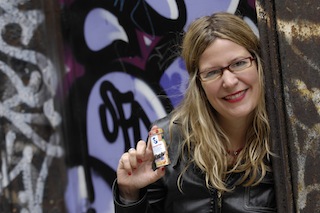I first met Sarah Endline sometime in 1997, and besides sharing the University of Michigan as our alma mater, we share a passion for social entrepreneurship that has kept us in touch over the years. She worked for NFTE from 1997-1999 and later founded her socially responsible and healthy candy company, sweetriot, in 2006. sweetriot has sold millions of units, has taken in millions in revenue, sources internationally, and is sold around the United States.
Sarah Endline, founder of sweetriot.
Sarah and I met for lunch recently to discuss her path to becoming a successful entrepreneur.
Steve Mariotti: Do you remember how we first met?
Sarah Endline: Yes, the person who introduced us was the then director of Students for Responsible Business- turned director of Net impact, Nancy Katz. I was meeting with Nancy, trying to find the right opportunities in New York in social entrepreneurship, and she said, "Do you know Steve Mariotti?" And I don't think we knew beforehand that we were both Michigan people. So I came to the office at 120 Wall Street, and I walked in, and we got along famously.
SM: You also went to the University of Michigan. Give people an idea of your path to successful entrepreneurship.
SE: I graduated from Michigan in 1994, after which I worked for many places, including AIESEC, the World Bank, NFTE, and Microsoft before getting my MBA at Harvard. I spent the summer at Yahoo while in graduate school, after which I went out to Silicon Valley for a few years before coming back to NYC and starting sweetriot in 2006.
I was actually writing business plans as early as Harvard, and I was always working on the entrepreneurial stuff, it just took me a couple of years to get to the point where it was the right business plan, and I decided to launch it.
SM: How did you go about deciding what your business was going to be?
SE: Well, I knew I wanted to start a socially responsible business, like Ben & Jerry's, where you took a consumer product that people loved and you put a social mission into it, and I thought, I can't do ice cream because that's Ben & Jerry's, and I'm not going to do cosmetics, because I'm not motivated enough about cosmetics,
So I was thinking about industries where I either loved them, I had experience, or I thought I could work 24/7, and that's where I looked at candy. It wasn't even chocolate when I started out, it was candy in a broader way.
I went to China, and was in and out of candy factories, and I thought maybe I would find a diamond in the rough in Asia, something I could just import into the U.S. market. I looked at all these factories and they weren't the products I wanted to create, because I was really looking for something natural and organic. As I looked more and more at chocolate, that's when I found that little cacao bean, and to me that's the center. The cacao fruit, the cacao bean are at the center of the candy industry.
SM: What was the hardest thing about getting sweetriot off the ground?
SE: I think what's challenging is that it's art and science. In that getting-ready-to-launch moment, you're writing a business plan, and you're searching for the right answer and gathering data, but theres a mix.
It's not just like you run formulas and the right answer pops out. That's not actually what happens. You're trying to conceive of what's possible, what's going on in the marketplace, and you're really trying to create the right answer, and that takes a lot of art and intuition.
SM: Did doing the business plan help you?
SE: It's interesting, I really believe in business plans, and I call BS on people that say, oh, they don't matter, because I think they matter most for the entrepreneur. I always tell people, don't do the business plan for others, do your business plan for you.
You need it because you need a road map in front of you. As an entrepreneur you have all these ideas flowing constantly through your head, and if you don't journal, and you don't put them in one place, you're not going to have a clear vision in front of you.
I remember putting consumer segments that I thought would be our core target audience for sweetriot in our business plan, and guess what? They weren't that at all, and that's OK. Because the key is that your business plan is a living, breathing document. People get hung up on it like it's a thesis, like it's set in stone. but it's first and foremost for the entrepreneur.
SM: How did your work experience help you?
SE: Well, take Yahoo for example. I went to Yahoo because I was a social entrepreneur and I saw the Internet changing the world, and I wanted to, in a way, be an anthropologist inside of it. At Yahoo, we were trying to build the very best products for consumers, so we were trying to include them in the design. Yahoo would study the way consumers lived their lives and try to see how their products fit into them. It's a form of anthropology called ethnography, and I absolutely used ethnography concepts in building sweetriot.
We were asking, how do people live and snack? Why do we give them this little tin of chocolate that fits in their purse or their office desk? Well, they can take it on the go, they have a busy lifestyle.
SM: How about Harvard? What was the major benefit of that experience?
SE: Harvard business school is a daily exercise in being a solutions-focused leader. You realize that every business has problems and challenges, and I say this constantly to my team: If you're a business leader that gets stuck on a problem, you will never move forward.
What Harvard does every day in class is, here's the challenge, what do you do? What do you do to move this forward? It's a classic, solutions focused problem solving technique. You gotta make the call, and move on. Sometimes you make the wrong call, but you're making the call. You're not getting stuck. You're not going to sit there in analysis paralysis. Take a stance and move forward. I feel like that's always going on, but rarely explicitly stated.
SM: Why do people buy your product? What was your insight into your market?
SE: Well, our first product line is really about very small chocolates, and portion control. When we started, on the front of our tin it said 140 calories, tallying up the total of calories in the package. But when we talked to consumers, the thing they really connected with was the fact it was one calorie per bite. So we changed the front of the tin to reflect what the consumers told us.
So many people are thinking about healthy snacks and are converting to natural-organic, we started thinking, what are the healthy ingredients of the future? So we have 85 percent pure dark, we have 70 percent dark with quinoa, we have 70 percent dark with coconut, and it's incredible. So combining chocolate with a healthy ingredient, to me, that's the snack of the future.
SM: At what moment did you see that? At what moment did you have your big insight?
SE: I was looking more at more at the origin of chocolate and starting to learn that chocolate was healthy. I was doing shelf research, macro research, and one-on-one focus groups, and I would ask things like, what are your best memories of candy? What problems do you have with chocolate? And people were like, they felt guilty, they wanted smaller portions, they didn't want to unwrap it.
Around the same time I went on another research trip to a bunch of European countries to see how they sold and ate chocolate. I went from London, to Zurich, to Paris, to Barcelona and Turin, Italy, and I went in and out of stores, and I think it was the first time I saw a chocolate-covered cacao nib. Around the same time I went to the Green festival in San Francisco, and they had these loose beans, and I was like, 'That's the chocolate bean?' I brought some home, and people didn't want to eat it raw. The idea of covering it with chocolate was really to give it a very desirable taste.
SM: How do you do valuation?
SE: I really think that again, in the beginning it is a mix of art and science. So you try to see what the market is doing, comparables in the industry, you're talking to other entrepreneurs and angel investors. I saw that a lot of comparable companies were between one and 5 million, and I just put myself in the middle.
(I am not alone in my praise of Sarah and her company; look at what others say here: http://www.sweetriot.com/about/press.php)
SM: What have you learned over the past eight years and what would you share with young entrepreneurs?
SE: First of all, I often think about this and its a cliche but:
1. Its a marathon not a sprint. Managing your emotions is really important
2. Begin with the end in mind. When you're going through the mud,you need an inner vision in front of you. I used to keep a journal so I would have a record of my thoughts.
3. We say a riot doesn't happen alone, but what that means in a broader way is that you have to Embrace and Empower a team. You can't do everything alone. Sooner you have a partnership/empowerment philosophy, the better.
I wish Sarah and all of sweetriot the best, and I know their success will continue in the future with the innovations they're working on as I write.

